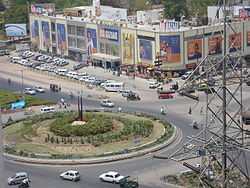Economy of Ahmedabad

Ahmedabad is the largest inland industrial center and the second largest industrial center in western India after Mumbai. The gross domestic product of Ahmedabad metro was estimated at $160 billion in 2010. It is the largest supplier of denim and one of the largest exporters of gems and jewellery in the country.[1]
The textile industry has been the main industry of Ahmedabad. On 30 May 1861, Ranchhodlal Chhotalal founded the first Indian textile mill called the Ahmedabad Spinning and Weaving Company Limited, to be more popularly known as the Shahpur Mill later on. This was followed with a series of textile mills like the Calico Mills in 1880 by Maganbhai, and other mills founded by industrialists like Ambalal Sarabhai and Kasturbhai Lalbhai which gave Ahmedabad the title of Manchester of India. The textile industry saw a decline in the early part of the 20th century, but was revived again due to the First World War and also by the Swadeshi movement led by Mahatma Gandhi during the independence movement.[2] Arvind Mills is one of the largest textile mills in the country. An Arvind mill is one of the three largest producers of denim in the world.[citation needed]
Ahmedabad G. D. P. was $65 billion in 2008. Ahmedabad also has a thriving chemicals and pharmaceuticals industry. Two of the biggest pharmaceutical companies of India - Zydus Cadila and Torrent Pharmaceuticals are located in the city. The city also serves as the corporate headquarters of the Adani Group which is a leading trading and export company of India. The Nirma group of industries running a large number of detergent and chemical industrial units in Gujarat, also has its corporate headquarters in the city.
The last few years has seen the rise of the Information Technology industry in Ahmedabad. A Nasscom survey in 2002 on the ‘Super Nine Indian Destinations’ for IT-enabled services (ITES) had ranked Ahmedabad fifth among the top nine most competitive cities in the country.[3] The real estate prices in the city are also booming due to the entry of large retail stores and also due to the Sabarmati Riverfront Development Project.
References
- ↑ Jawaharlal Nehru National Urban Renewal Mission (2006). "Profile of the City Ahmedabad". Ahmedabad Municipal Corporation Ahmedabad, Urban Development Authority and CEPT University, Ahmedabad. Ahmedabad Municipal Corporation. Retrieved 2008-07-22.
- ↑ "The Ahmedabad Chronicle, Imprints of a millennium", page 34. Vastu-Shilpa Foundation for Studies and Research in Environmental Design, 2002
- ↑ ""Ahmedabad joins ITES hot spots", The Economic Times, 16 August 2002". Retrieved 2006-05-14.